Venturing to Japan is not just a journey through geography; it’s a profound exploration of culture and tradition. Among the many captivating facets of Japanese heritage, kimono and yukata is a vivid canvas, telling stories of centuries-old customs, aesthetics, and the graceful journey through time.
As you meticulously plan your trip to the enchanting Land of the Rising Sun, the alluring prospect of donning a kimono or yukata beckons you. It’s an invitation to observe and actively participate in Japan’s living tapestry.
These elegant garments are more than just pieces of fabric; they’re a tangible connection to Japan’s past, manifesting the country’s enduring commitment to preserving its heritage. Every fold, pattern, and color in a kimono or yukata carries a story reflecting regional traditions and personal expression.
Wearing a kimono allows you to step into the past, feeling the weight of history on your shoulders while experiencing the timeless grace of this attire. Each kimono is a work of art, often reflecting the changing seasons, with colors and motifs harmonizing with nature.
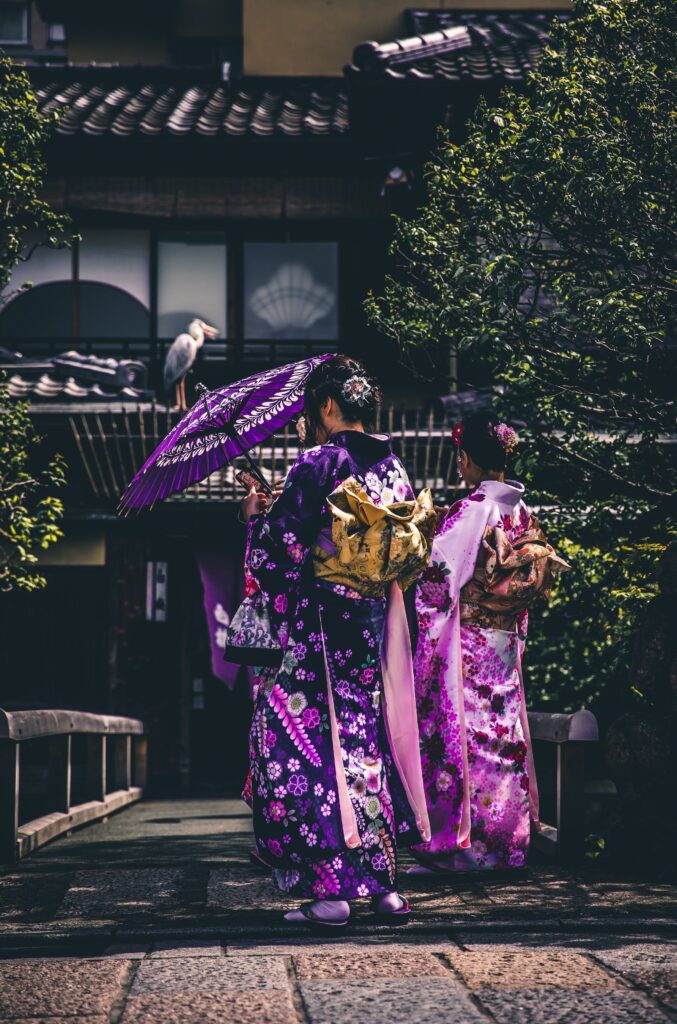
Kimono: A Seasonal Canvas
On the other hand, the yukata, a lighter, more casual cousin to the kimono, is perfect for hot summer days and festive occasions. Its patterns and colors are often bold and vivid, capturing the lively spirit of summer festivals and celebrations.
By wearing these traditional garments, you celebrate Japan’s rich cultural heritage and become an integral part of it. You’ll walk through ancient temples, vibrant streets, and serene gardens, feeling the whispers of history and the echoes of tradition.
Pro Tips for the Savvy Traveler
And here’s a pro tip for the savvy traveler: Look out for rental shops and local experts who can help you choose and don these garments, ensuring you’re both respectful of tradition and looking your very best. Plus, as a visitor to Japan, you may even discover tax-free shopping options when you explore the world of traditional attire.
So, as you plan your Japanese adventure, remember that it’s not just about seeing the sights; it’s about participating in the living history, embracing the aesthetic beauty, and becoming a part of the exquisite tapestry of Japan’s culture. 🇯🇵👘 #JapaneseFashion #KimonoAdventures #CulturalJourney”
A Tale of Tradition: The Kimono and Yukata
The kimono and Yukata are more than garments; they are vessels of history and expressions of identity. With its intricate designs and meticulous craftsmanship, the kimono traces back centuries, symbolizing formality, tradition, and refinement. On the other hand, the Yukata, a lighter and more casual version, has evolved to embody the carefree spirit of festivals and summer outings.
Weaving Threads of Culture: The Art of Dressing
Putting on a kimono or Yukata isn’t just about clothing—it’s a ritual. Each fold, each knot, carries significance, reflecting the wearer’s age, status, and the occasion. As you slip into these garments, you’re stepping into the footsteps of generations before you.
The Dance of Patterns: Symbolism and Aesthetics
Every pattern on a kimono or Yukata tells a story. From vibrant florals celebrating nature to intricate motifs that evoke harmony, each design carries a symbolism that whispers tales of love, joy, and cultural narratives.
The creation of a kimono or Yukata is a labor of artistry. The meticulous handiwork, the delicate stitches, and the attention to detail reflect Japan’s reverence for craftsmanship and the pursuit of perfection.
Where Tradition Meets Modernity: Where to Wear Them
Kimonos, formerly an everyday attire, has become a symbol of grace and refinement. Cultural events and tea ceremonies offer the perfect setting to truly admire the beauty of exquisite kimonos.On the other hand, Yukata are typically associated with summer festivals and provide an opportunity to participate in Japan’s festive atmosphere.
Capturing Memories: The Joy of Wearing Traditional Attire
Stepping out in a kimono or Yukata isn’t just an outfit choice; it’s a memory in the making. The swish of fabric, the embrace of tradition, and the moments captured in photographs are souvenirs that time cannot erase.
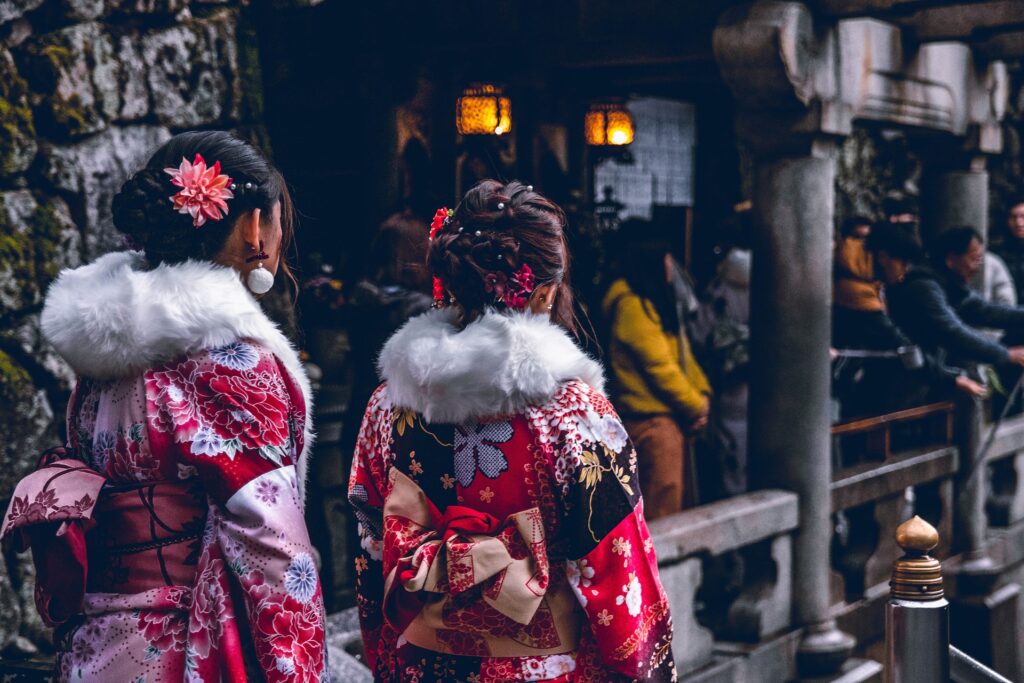
Embrace the Elegance: Your Journey Awaits
As you embark on your journey through Japan, the allure of traditional clothing awaits. Whether you choose the formality of a kimono or the festive charm of a yukata, know that you’re not just wearing fabric—you’re wearing stories, dreams, and the rich cultural heritage of Japan. From the hush of tea ceremonies to the jubilant energy of festivals, your attire becomes a passport that grants you access to the heart of Japan’s beauty and grace. So, fellow lovers of culture and fashion, let the transformation begin—let the kimono and Yukata guide you on a voyage of elegance and tradition, one fold at a time.
Klook.comWeaving Threads of Time: Unraveling the History of Kimono and Yukata
In the fabric of Japan’s past, the tale of kimono and yukata unfolds—a narrative that spans centuries, cultures, and the evolution of style. As you delve into the annals of history, you’ll discover how these garments, once reserved for aristocracy, have been woven into Japanese identity.
Origins in Elegance: A Glimpse into Heian Japan
The roots of kimono and yukata reach back to the Heian period, a time of cultural flourishing and artistic expression. Initially, these garments adorned the elite, serving as a symbol of social status and refinement. Their design, characterized by flowing lines and bold colors, reflected the era’s aesthetics.
Embracing Evolution: From Aristocracy to Everyday Life
With time, the kimono transcended its noble origins and made its way into the lives of commoners. No longer confined to the imperial court, these garments became a canvas for self-expression, each fold and pattern reflecting personal tastes and societal shifts.
Silk and Splendor: The Kimono’s Regal Charm
The kimono, adorned with its intricate patterns and rich hues, became a manifestation of craftsmanship. Artisans dedicated themselves to dyeing, weaving, and embroidery, transforming silk into wearable masterpieces that celebrated nature, legends, and daily life.
Yukata: A Breath of Summer Breeze
As the seasons shifted, the yukata emerged as a summer variation of the kimono. The yukata makes for a comfortable and practical clothing option during summer festivals and leisurely walks due to its lightweight cotton material. The playful patterns often showcase lively colors and whimsical motifs.
Defying Time: The Enduring Appeal
Through shifting eras and changing fashion sensibilities, the allure of kimono and yukata endured. While contemporary attire emerged, these traditional garments continued to hold a place in Japan’s cultural consciousness, a bridge between past and present.
Symbolism and Significance: More Than Fabric
Beyond being attire, kimono and yukata hold layers of symbolism. They symbolize tradition, heritage, and the artistry of generations. They celebrate cultural narratives and serve as a vessel for stories, each thread a testament to the connection between wearers and the world around them.
Preserving Tradition: An Unfolding Legacy
Today, as you don a kimono or yukata, you’re enveloping yourself in a legacy that stretches beyond centuries. Whether you’re partaking in a tea ceremony, attending a festival, or simply exploring the streets of Japan, these garments continue to breathe life into history, embodying the essence of elegance, culture, and the journey of time itself.
Kimono: The Elegance of Artistry and Tradition
In traditional Japanese attire, the kimono symbolizes exquisite craftsmanship, a vessel of cultural significance, and a canvas for self-expression. As you delve into the intricate folds of this iconic garment, you’ll uncover a world where fabric becomes poetry and history becomes thread.
Craftsmanship Unveiled: A Cloak of Tradition
The kimono is more than a garment; it embodies artistry. Each kimono is a fusion of meticulous design, vibrant hues, and delicate craftsmanship that mirrors the beauty of Japan’s landscapes and narratives.
Elegance in Every Fold: A Tale of Occasions
Kimono is not just clothing but also a symbol of grandeur reserved for special occasions such as weddings, tea ceremonies, and formal events, turning them into timeless memories.
Patterns that Whisper: Language of the Kimono
Patterns on a kimono are stories woven into silk. From blossoms that herald spring’s arrival to cranes that signify longevity, each motif holds symbolism. The patterns aren’t just designs—they’re cultural narratives that wrap around the wearer.
Accessorizing Excellence: Completing the Ensemble
The kimono isn’t complete without its partners in elegance. The wide obi belt cinches the garment with grace, zori sandals echo tradition underfoot, and the kinchaku handbag adds a touch of functionality to the ensemble.
From Past to Present: A Living Legacy
As you slip into a kimono, you’re stepping into a river of time, embracing not just a piece of clothing but the heritage of Japan. The kimono’s evolution from imperial court to contemporary culture speaks of its adaptability and the love affair it shares with generations.
Your Kimono Tale: An Experience to Cherish
As you wear a kimono, you’re not just wearing attire; you’re wearing tradition, craftsmanship, and stories. You’re becoming part of a narrative that traverses eras and encapsulates the soul of a nation known for its art, grace, and timeless elegance. So, whether you’re attending a wedding or sipping tea at a ceremony, let your kimono carry you into the heart of Japan’s enchanting world.
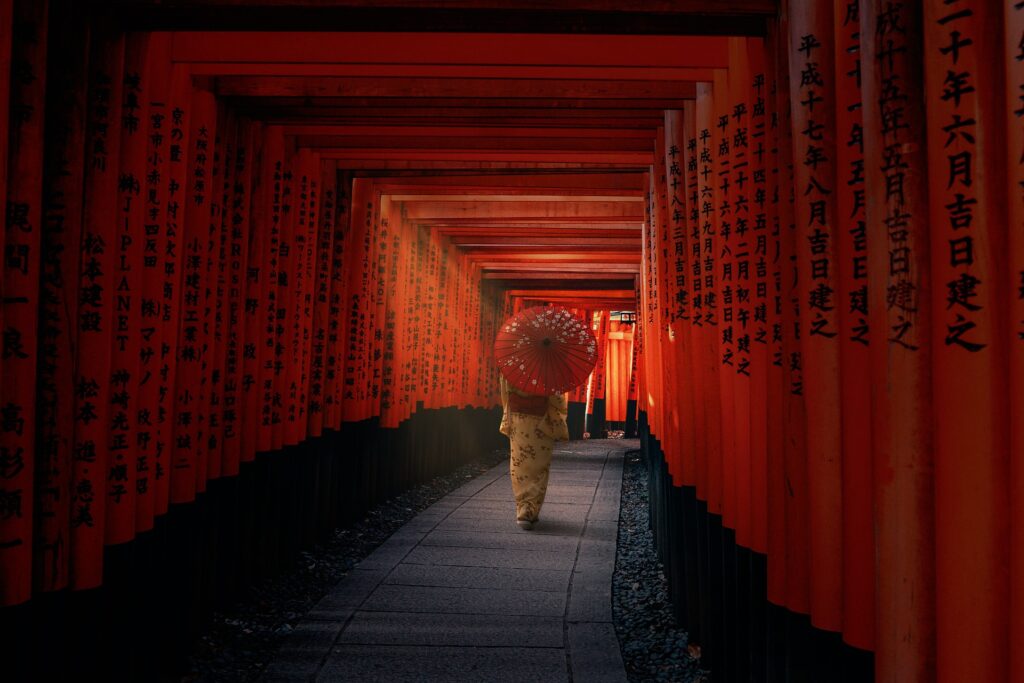
Adorning Tradition: Where to Grace the Kimono
The allure of the kimono extends beyond its intricate beauty—it’s an invitation to step into Japan’s history and culture. From historic streets to cultural gatherings, here’s where you can unfurl the elegance of the kimono.
Historic Enclaves: Kyoto and Asakusa
Japan’s historic districts hold the perfect backdrop for your kimono escapade. Shops in areas like Kyoto and Asakusa offer an array of kimono styles, colors, and accessories for rent. Wander the cobbled streets, past ancient temples and traditional buildings, as your kimono whispers stories of a bygone era.
Draped in Grace: Tea Ceremonies and Formal Events
A kimono is more than attire—it’s a transformation. Immerse yourself fully by wearing it to a tea ceremony or formal event. As you partake in age-old rituals, you’re not just a spectator but a participant in Japan’s cultural legacy.
Innate Elegance: Hotels and Ryokans
Some hotels and ryokans offer guests the chance to experience the kimono. It’s not just an outfit; it’s a memory etched in time. Whether sipping tea in a serene garden or lounging in your tatami room, the kimono enchases your stay.
Theatrical Charms: Festivals and Performances
Specific festivals and cultural performances provide the stage for your kimono debut. Dance through festivals, immerse in the drama of traditional performances, and let your attire become a part of the vibrant tapestry of these events.
Capture the Moment: Temples and Shrines
Pay homage to Japan’s spiritual sites in the graceful embrace of a kimono. Standing before temples and shrines, you’re more than a visitor—a participant in the country’s reverence for tradition.
Your Journey, Your Kimono
Wherever you choose to wear a kimono, know that you’re not just wearing clothing—you’re wearing history, culture, and the grace of Japan. Each fold and step becomes a chapter in your personal tale of exploration. So, whether you’re strolling through Kyoto’s ancient streets, sipping matcha tea, or capturing photos against the backdrop of revered shrines, let the kimono guide you into a world where the past and present harmoniously embrace.
Klook.comYukata: Embracing Casual Comfort and Festive Charm
As summer’s embrace envelops Japan, the yukata emerges—a garment that marries comfort, style and the joyful spirit of festivals. In the tapestry of traditional Japanese clothing, the yukata stands as a refreshing breeze, inviting you to immerse in the warmth of the season and the allure of culture.
A Casual Elegance: Unveiling the Yukata
The yukata is the embodiment of casual elegance. Crafted from lightweight cotton, it gracefully drapes the wearer in a cocoon of comfort. Unlike its more formal sibling, the kimono, the yukata’s designs are more straightforward, reflecting the carefree spirit of summer.
A Symphony of Simplicity: Design and Fabric
Yukatas are a canvas of simplicity and charm. Though more understated, the patterns retain the essence of Japan’s aesthetics. Each design adds a touch of artistry to the fabric, from delicate florals to geometric motifs.
A Season’s Companion: Yukata and Summer Festivals
When summer arrives, so does the yukata. With its breathable fabric and easy-to-wear nature, it becomes the garment of choice for festivals, fireworks, and outdoor celebrations. As lanterns sway and the air fills with laughter, the yukata brings a vibrant touch to the festivities.
Effortless Elegance: Dressing in Yukata
Dressing in a yukata is a breeze—quite fitting for the associated season. The obi belt is narrower, and the overall ensemble exudes casual charm. You’re ready to step into the world in mere moments, a vision of comfort and style.
More than Attire: Yukata and Tradition
While the yukata is synonymous with summer revelry, it’s not devoid of tradition. It embodies the essence of celebrating fleeting moments, basking in the joy of the present, and paying homage to the cultural rituals that define Japan.
Your Yukata Adventure: Where to Don the Attire
The yukata isn’t just an outfit; it’s an experience. As you embrace its casual elegance, consider donning it at summer festivals, where its spirit aligns with the jovial atmosphere. Wander through illuminated streets, watch fireworks burst in the night sky, and dance to the rhythm of traditional performances—your yukata adds a layer of vibrancy to every step.
A Canvas of Celebration: Your Yukata Journey
With every thread, every pattern, the yukata tells a tale of summer’s enchantment and cultural legacy. Whether you’re celebrating at a festival, joining friends for a fireworks spectacle, or simply enjoying a leisurely stroll, your yukata becomes a brushstroke on the canvas of a season marked by celebration, camaraderie, and cherished memories.
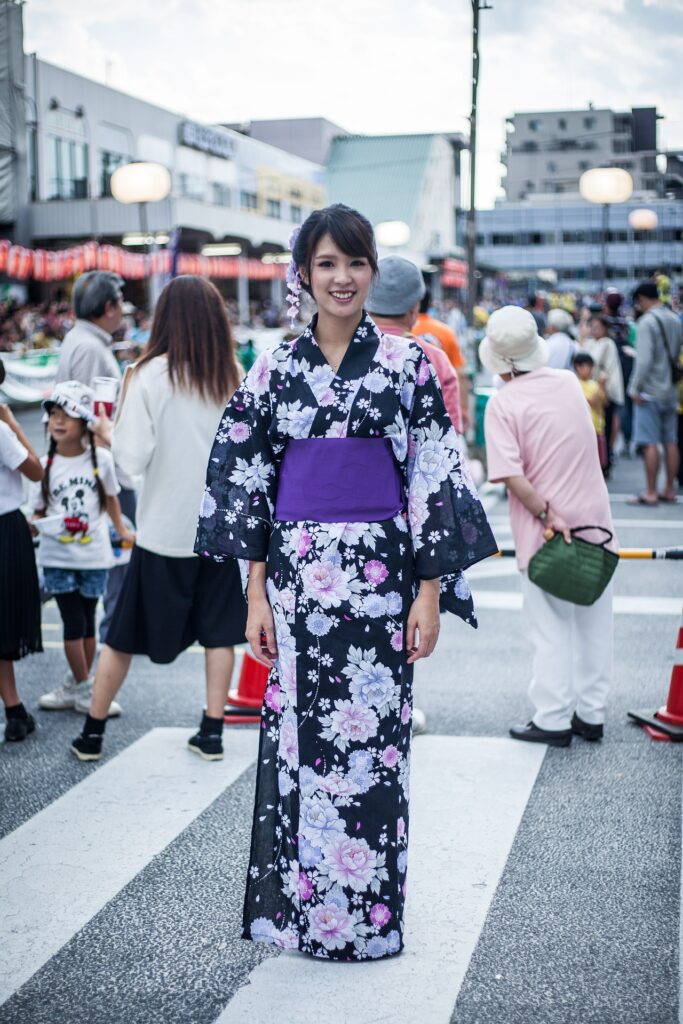
Draped in Summer Splendor: Where the Yukata Unfurls
The yukata emerges from its slumber when the sun paints the sky with warmth and the air hums with the promise of celebration. From festivals to tranquil escapes, here’s where you can slip into the yukata’s embrace and dance through the season.
Festivals and Fireworks: Yukata and Celebration
Summer festivals and fireworks displays become a canvas for your Yukata debut. As lanterns sway and the night sky ignites with colors, your yukata adds a touch of elegance to the jubilant atmosphere. Dance, laugh, and capture moments that shimmer like stars.
Cultural Alchemy: Yukata and Onsen Retreats
Hot springs and ryokans are sanctuaries of relaxation, and the yukata finds its perfect companion in these havens. Slip into the soothing waters of an onsen, the yukata’s soft fabric a gentle caress against your skin. As you unwind, you’re not just in a robe but immersed in a tradition that marries comfort and culture.
Strolls of Elegance: Amidst Gardens and Streets
A stroll becomes an elegant affair when you don the yukata. Amidst the serene beauty of Japanese gardens or along the bustling streets of cities, your yukata becomes a companion that elevates the every day into the extraordinary.
Tales of Tradition: Tea Ceremonies and Gatherings
For those who seek the heart of Japanese culture, the yukata becomes a passport to authentic experiences. Wear it to a tea ceremony, a cultural workshop, or a traditional gathering, and you’ll find yourself not just a guest but an active participant in the tapestry of tradition.
Nurturing Memories: Your Yukata Journey
The yukata isn’t just an outfit; it’s an experience etched in time. Whether amidst the magic of a festival, basking in the serenity of an onsen, or taking a simple stroll, each moment becomes a part of your yukata journey. With each step, you’re not just wearing fabric—you’re wearing the essence of summer, the charm of culture, and the beauty of being fully present in Japan’s enchanting embrace.
Klook.comKimono and Yukata: Embrace the Timeless Elegance
The kimono and yukata are notes of Japan’s cultural heritage in the symphony of tradition and style. These garments aren’t just clothing; they carry the essence of centuries, whispering stories of grace, celebration, and the artistry of generations.
Threads of Time: Wearing the Past
When you don a kimono or yukata, you’re not just wearing fabric—you’re enveloping yourself in history. Whether it’s the intricate patterns of a kimono or the casual charm of a yukata, you’re stepping into a narrative that spans generations, witnessing the evolution of Japan’s fashion and identity.
Personal Narratives: The Magic of Styling
With creativity, you can transform your kimono or yukata into a masterpiece that reflects your personality. The way you tie your obi, the accessories you choose, and how you carry yourself—each detail weaves a story of your unique journey.
Moments of Grandeur: Special Occasions
For weddings, ceremonies, and formal events, the kimono is an embodiment of elegance. It’s more than attire; it reflects the significance of the moment, a statement of respect for tradition and culture.
Summer’s Embrace: Festive Yukata
As summer’s warmth envelops Japan, the yukata emerges with a carefree spirit. It’s an invitation to join in the festivities, to dance under the stars, and to celebrate the season’s vibrancy with fellow revelers.
Legacy of Culture: Your Experience Awaits
The kimono and yukata aren’t just garments but pathways to understanding Japan’s culture and history. As you step into them, you’re stepping into a world where fashion is a testament to art, clothing is a conduit for stories, and wearing becomes a form of homage.

Differences Between Kimono and Yukata
When exploring traditional Japanese attire, it’s important to grasp the nuances that distinguish kimono and yukata, two iconic garments with specific characteristics tailored for different occasions and seasons. Let’s delve into a more detailed comparison, including tables and listings for clarity.
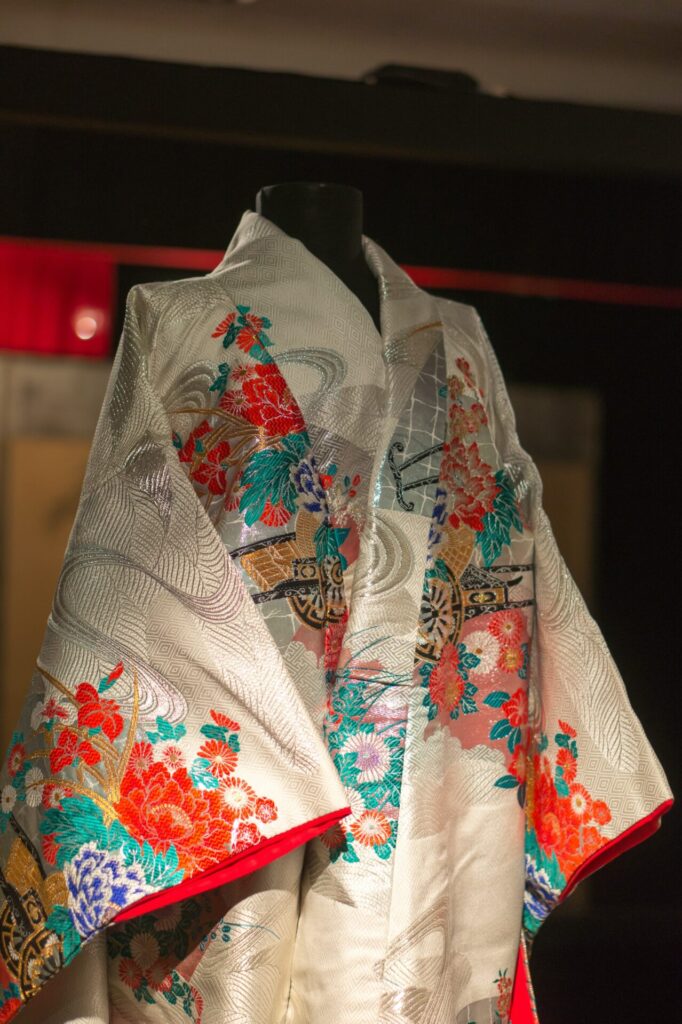
1. Formality:
| Aspect | Kimono | Yukata |
|---|---|---|
| Occasions | Formal events such as weddings, tea ceremonies, and official gatherings. | Casual and relaxed occasions, such as summer festivals, hot spring visits, and informal outings. |
| Fabric | Luxurious materials like silk, brocade, and satin, known for their opulent textures and colors. | Lightweight materials like cotton or synthetic fabrics, ideal for hot weather. |
| Patterns | Elaborate designs with intricate motifs, often reflecting traditional or familial symbols. | Simpler, bold patterns featuring florals, geometric shapes, or seasonal themes. |
| Accessories | Multiple accessories, including an obi (wide belt), obijime (decorative cord), zori (formal sandals), and various hairpins. | Fewer accessories required, typically a narrow obi and geta sandals, making the outfit easier to put on. |
2. Fabric and Design:
Kimonos boast a rich array of fabrics and intricate designs, often reflecting the formality of the occasion:
- Fabrics include silk, brocade, satin, and more, offering a wide range of textures and colors.
- Designs are intricate, showcasing motifs like chrysanthemums, dragons, or cranes, carrying deeper cultural and symbolic meanings.
Yukatas, designed for comfort and ease of wear during the summertime, exhibit distinct features:
- Fabric choices focus on lightweight materials like cotton, synthetic fabrics, or even linen to combat the heat.
- Designs are simpler and more casual, featuring colorful patterns like cherry blossoms, fireworks, or even characters from pop culture.
3. Occasions:
While both kimono and yukata have their unique places in Japanese culture, their selection is largely dictated by the formality of the event:
Kimono is ideal for:
- Formal and solemn events, including weddings, tea ceremonies, graduations, and other traditions.
- Demonstrating deep respect and reverence for the significance of the occasion.
Yukata shines at:
- Casual and festive gatherings, such as summer festivals, fireworks displays, and outings to hot spring resorts.
- Blending with the lively and relaxed atmosphere of these events.
In summary, kimono and yukata offer distinct choices for various occasions and preferences. The choice between these traditional garments depends on the formality of the event, the season, and the desired level of elegance or comfort. Whether you opt for the timeless grace of a kimono or the laid-back charm of a yukata, both enable you to engage with Japan’s rich cultural heritage in a unique and meaningful way.
How To Wear Kimono And Yukata
Wearing a Kimono:
- Start with Undergarments: Begin with a white undergarment called “nagajuban.” It’s similar to a robe and is worn close to your body. Ensure the collar is neatly arranged.
- Layer with Hadajuban: On top of the nagajuban, wear a lightweight, full-length slip called “hadajuban.” This provides a smooth base for the kimono.
- Drape the Kimono: Unfold the kimono, ensuring the left side crosses over the right side. The right-over-left configuration is typically reserved for the deceased, so getting this step right is crucial.
- Secure with Obi: Wrap the kimono around your body and secure it with an Obi, a wide sash. Ensure the kimono’s hem falls just above your ankle. Adjust the collar and sleeves for a neat appearance.
- Tie the Obi Knot: Create a bow or knot with the Obi at your back. The style and intricacy of the knot can vary depending on the formality of the occasion and personal preference.
- Adjust the Obi Bow: Adjust the Obi bow to sit at your lower back, creating a beautifully symmetrical appearance. The ends of the Obi should hang gracefully.
- Final Touches: To complete the ensemble, choose accessories such as “tabi” socks, “zori” sandals, and various hairpins. These should complement the formality and style of your kimono.
Wearing a Yukata:
- Dress in Undergarments: Begin with a slip or undergarments similar to those worn with a kimono. These create a smooth and comfortable base for the yukata.
- Wrap the Yukata: Take the yukata and wrap it around your body, ensuring the left side crosses over the right side, just like with a kimono.
- Secure with an Obi: Unlike the wider Obi used with kimonos, yukatas are typically secured with a more narrow Obi sash. Tie it in the front or side, creating a more casual and comfortable look.
- Adjust the Obi Knot: You can opt for a simple knot with the Obi, and some yukatas even come with pre-tied obis. Make sure it’s secure and comfortable.
- Choose Geta Sandals: Complete your yukata outfit with “geta” sandals, often wood-made. These are a comfortable choice for walking during warm-weather events.
The kimono and yukata hold great cultural significance and reflect respect for tradition. By following these step-by-step instructions, anyone can appreciate the art and beauty of Japanese traditional attire.
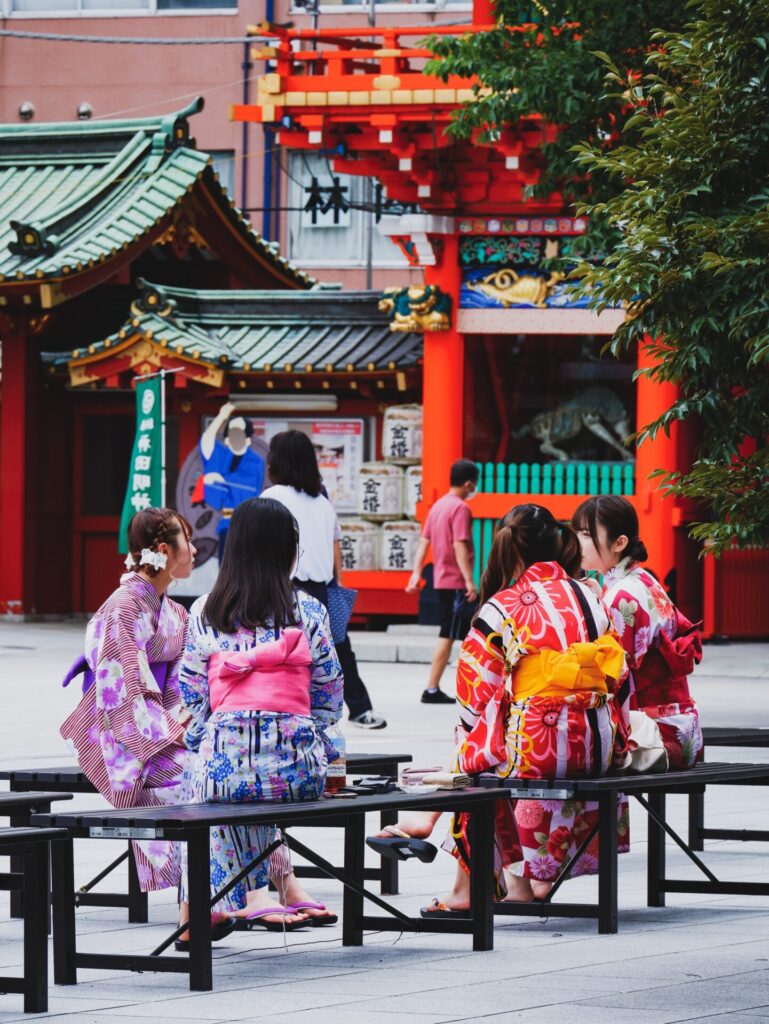
FAQ: Kimono and Yukata
Q1: What is the difference between a kimono and a yukata?
A: The key differences lie in formality and fabric. Kimonos are formal, made from luxurious materials like silk, and worn for special occasions. Yukatas are more casual, typically made of cotton or synthetic materials, and worn during relaxed, festive events in the summer.
Q2: How do I put on a kimono or yukata?
A: Both garments involve several steps, including undergarments and sash tying. It’s often best to seek assistance from someone experienced. Many rental places or hotels in Japan provide dressing services.
Q3: Can I wear a kimono or yukata as a foreigner in Japan?
A: Both are available for rent at many places in Japan. It’s a beautiful way to embrace Japanese culture. Remember to be respectful and follow dressing and etiquette guidelines.
Q4: Are there specific occasions for wearing kimonos or yukatas?
A: Kimonos are worn for formal events like weddings and tea ceremonies, while yukatas are perfect for summer festivals, casual outings, and hot spring visits.
Q5: How do I choose the proper kimono or yukata for me?
A: Selection depends on personal preference, event formality, and season. Kimonos offers more design and color options. Yukatas are typically more relaxed and vibrant.
Q6: What accessories are worn with kimonos and yukatas?
A: Kimonos may be accompanied by an obi (sash), obijime (decorative cord), zori sandals, and various hairpins. Yukatas are more straightforward, with a narrow obi, geta sandals, and often kanzashi (hairpins).
Q7: Can I purchase my kimono or yukata?
A: You can buy your own, but it’s a significant investment. You’ll also need to learn how to put them on correctly or have someone assist you.
Q8: Are there any cultural rules or etiquette I should know when wearing a kimono or yukata?
A: Yes, there are many etiquette guidelines. For example, ensure the left side crosses over the right when wearing them, as the opposite is associated with dressing for the deceased. It’s also important to be respectful at formal events and follow local customs and traditions.
Q9: Can men wear kimonos and yukatas too?
A: Absolutely. Men and women wear both kimonos and yukatas. The styles and designs may differ, but the cultural significance is the same.
Q10: Are there different regional variations of kimono and yukata?
A: Yes, there are regional and seasonal variations. Heavier kimonos are worn in colder regions, while lighter yukatas are favored in summertime. Regional patterns and designs can also vary, showcasing diverse cultural influences.
Wearing a kimono or yukata is a cherished cultural experience in Japan. By understanding the differences, respecting etiquette, and choosing the fitting garment for the occasion, anyone can immerse themselves in the elegance and traditions of Japanese attire.
Klook.comA Journey in Threads: Yours to Discover
So, whether standing before a mirror, tying your obi with care, or strolling through historic streets, know that you’re not just wearing a kimono or yukata—you’re embracing a piece of Japan’s soul. These garments hold within them the wisdom of generations, the elegance of eras past, and the potential to create moments that linger in memory. Let the kimono or yukata become your key to a deeper connection with Japan’s heritage and an unforgettable brushstroke on the canvas of your journey.

Travel Directory | Travel Japan(Japan National Tourism Organization)

















